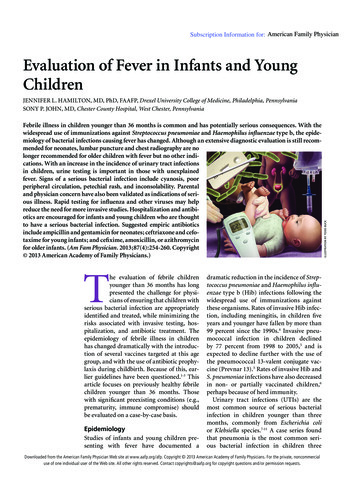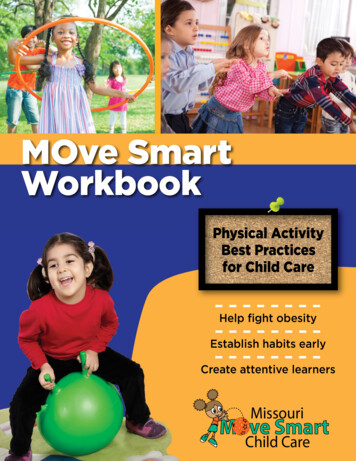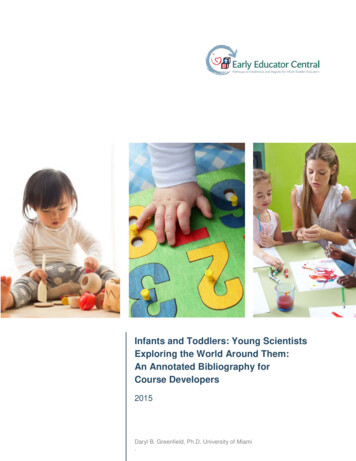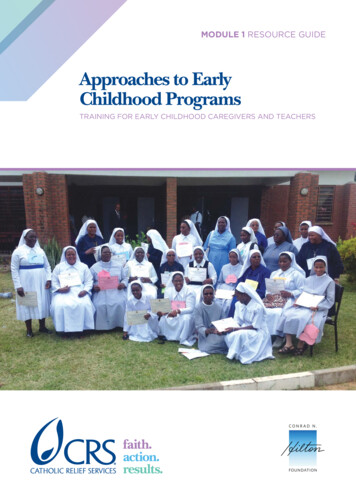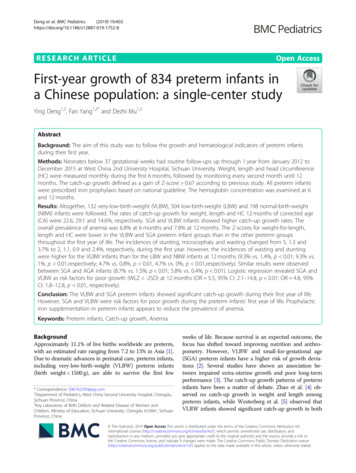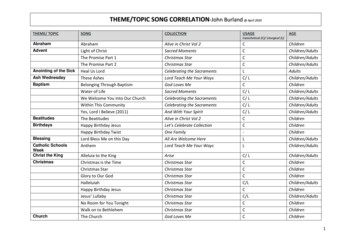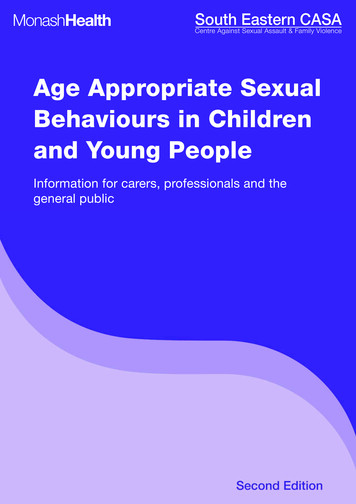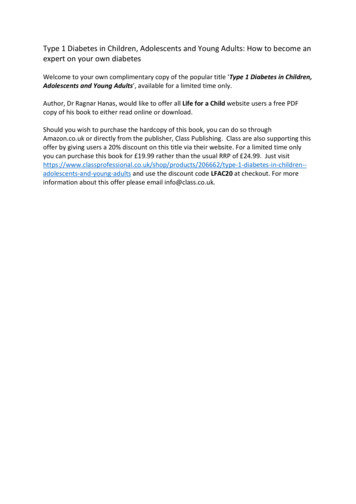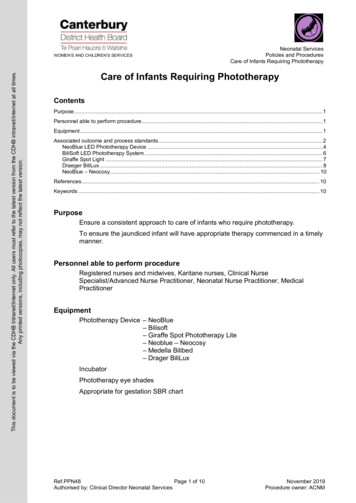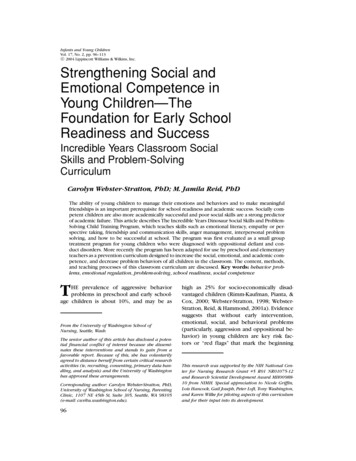
Transcription
LWW/IYCAS265-02March 5, 200416:10Char Count 0Infants and Young ChildrenVol. 17, No. 2, pp. 96–113c 2004 Lippincott Williams & Wilkins, Inc. Strengthening Social andEmotional Competence inYoung Children—TheFoundation for Early SchoolReadiness and SuccessIncredible Years Classroom SocialSkills and Problem-SolvingCurriculumCarolyn Webster-Stratton, PhD; M. Jamila Reid, PhDThe ability of young children to manage their emotions and behaviors and to make meaningfulfriendships is an important prerequisite for school readiness and academic success. Socially competent children are also more academically successful and poor social skills are a strong predictorof academic failure. This article describes The Incredible Years Dinosaur Social Skills and ProblemSolving Child Training Program, which teaches skills such as emotional literacy, empathy or perspective taking, friendship and communication skills, anger management, interpersonal problemsolving, and how to be successful at school. The program was first evaluated as a small grouptreatment program for young children who were diagnosed with oppositional defiant and conduct disorders. More recently the program has been adapted for use by preschool and elementaryteachers as a prevention curriculum designed to increase the social, emotional, and academic competence, and decrease problem behaviors of all children in the classroom. The content, methods,and teaching processes of this classroom curriculum are discussed. Key words: behavior problems, emotional regulation, problem-solving, school readiness, social competenceTHE prevalence of aggressive behaviorproblems in preschool and early schoolage children is about 10%, and may be asFrom the University of Washington School ofNursing, Seattle, Wash.The senior author of this article has disclosed a potential financial conflict of interest because she disseminates these interventions and stands to gain from afavorable report. Because of this, she has voluntarilyagreed to distance herself from certain critical researchactivities (ie, recruiting, consenting, primary data handling, and analysis) and the University of Washingtonhas approved these arrangements.Corresponding author: Carolyn Webster-Stratton, PhD,University of Washington School of Nursing, ParentingClinic, 1107 NE 45th St, Suite 305, Seattle, WA 98105(e-mail: cws@u.washington.edu).96high as 25% for socio-economically disadvantaged children (Rimm-Kaufman, Pianta, &Cox, 2000; Webster-Stratton, 1998; WebsterStratton, Reid, & Hammond, 2001a). Evidencesuggests that without early intervention,emotional, social, and behavioral problems(particularly, aggression and oppositional behavior) in young children are key risk factors or “red flags” that mark the beginningThis research was supported by the NIH National Center for Nursing Research Grant #5 R01 NR01075-12and Research Scientist Development Award MH0098810 from NIMH. Special appreciation to Nicole Griffin,Lois Hancock, Gail Joseph, Peter Loft, Tony Washington,and Karen Wilke for piloting aspects of this curriculumand for their input into its development.
LWW/IYCAS265-02March 5, 200416:10Char Count 0Classroom Social Skills Dinosaur Programof escalating academic problems, grade retention, school drop out, and antisocial behavior(Snyder, 2001; Tremblay, Mass, Pagani, &Vitaro, 1996). Preventing, reducing, and halting aggressive behavior at school entry, whenchildren’s behavior is most malleable, is abeneficial and cost-effective means of interrupting the progression from early conductproblems to later delinquency and academicfailure.Moreover, strengthening young children’scapacity to manage their emotions and behavior, and to make meaningful friendships,particularly if they are exposed to multiplelife-stressors, may serve an important protective function for school success. Researchhas indicated that children’s emotional, social,and behavioral adjustment is as important forschool success as cognitive and academic preparedness (Raver & Zigler, 1997). Childrenwho have difficulty paying attention, following teacher directions, getting along with others, and controlling negative emotions, doless well in school (Ladd, Kochenderfer, &Coleman, 1997). They are more likely to berejected by classmates and to get less positivefeedback from teachers which, in turn, contributes to off task behavior and less instruction time (Shores & Wehby, 1999).Parent education programsHow, then, do we assure that children whoare struggling with a range of emotional andsocial problems receive the teaching and support they need to succeed in school? Oneway is to work with parents to provide themwith positive parenting strategies that willbuild their preschool children’s social competencies and academic readiness. Researchshows that children with lower emotionaland social competencies are more frequentlyfound in families where parents express morehostile parenting, engage in more conflict,and give more attention to children’s negativethan positive behaviors (Cummings, 1994;Webster-Stratton & Hammond, 1999). Children whose parents are emotionally positiveand attend to prosocial behaviors are morelikely to be able to self-regulate and respond in97nonaggressive ways to conflict situations. Indeed, parent training programs have been thesingle most successful treatment approach todate for reducing externalizing behavior problems (oppositional defiant disorder (ODD)and conduct disorder (CD) in young children(Brestan & Eyberg, 1998).A variety of parenting programs have resulted in clinically significant and sustainedreductions in externalizing behavior problems for at least two third of young children treated (eg, for review, see Brestan &Eyberg, 1998; Taylor & Biglan, 1998). The intervention goals of these programs are to reduce harsh and inconsistent parenting whilepromoting home-school relationships. Theseexperimental studies provide support for social learning theories that highlight the crucial role that parenting style and disciplineeffectiveness play in determining children’ssocial competence and reducing externalizing behavior problems at home and in theclassroom (Patterson, DeGarmo, & Knutson,2000). More recently, efforts have been madeto implement adaptations of these treatmentsfor use as school-based preschool and earlyschool prevention programs. A review of theliterature regarding these parenting prevention programs for early school age childrenindicates that this approach is very promising (Webster-Stratton & Taylor, 2001). Whilethere is less available research with preschoolchildren, the preliminary studies are also quitepromising. In our own work, we targeted allparents who enrolled in Head Start (childrenages 3–5 years). In 2 randomized trials of 500parents, we reported that the Incredible Yearsparenting program was effective in strengthening parenting skills for a multiethnic groupof parents of preschoolers (Webster-Stratton,1998; Webster-Stratton et al., 2001a). Externalizing behaviors were significantly reducedfor children who were showing above averagerates of these behaviors at baseline. Motherswith mental health risk factors, such as highdepressive symptomatology, reported physical abuse as children, reported substanceabuse, and high levels of anger were ableto engage in the parenting program and to
LWW/IYCAS265-0298March 5, 200416:10Char Count 0INFANTS AND YOUNG CHILDREN/APRIL–JUNE 2004benefit from it at levels comparable to parents without these mental health risk factors(Baydar, Reid, & Webster-Stratton, 2003).Similar results were obtained in an independent trial in Chicago with primarily AfricanAmerican mothers who enrolled their toddlers in low-income day care centers (Gross,Fogg, Webster-Stratton, Garvey, & Grady,2003).Teacher trainingA second approach to preventing and reducing young children’s behavior problemsis to train teachers in classroom managementstrategies that promote social competence.Teachers report that 16% to 30% of the students in their classrooms pose ongoing problems in terms of social, emotional, and behavioral difficulties (Raver & Knitzer, 2002).Moreover, there is substantial evidence showing that the way teachers interact with thesestudents affects their social and emotionaloutcomes. In a recent study, Head Start centers were randomly assigned to an intervention condition that included the IncredibleYears parent training and teacher trainingcurricula or to a control condition that received the usual Head Start services. In classrooms where teachers had received the 6-daytraining workshop, independent observationsshowed that teachers used more positiveteaching strategies and their students weremore engaged (a prerequisite for academiclearning) and less aggressive than students incontrol classrooms (Webster-Stratton, Reid, &Hammond, in press). Another study with children diagnosed with ODD/CD showed thatthe addition of teacher training to the parent training program significantly enhancedchildren’s school outcomes compared toconditions that only offered parent training(Bierman, 1989; Kazdin, Esveldt, French, &Unis, 1987; Ladd & Mize, 1983; Lochman &Dunn, 1993; Shure, 1994; Webster-Strattonet al., in press). Overall, the research on collaborative approaches to parent- and teachertraining suggests that these interventions canlead to substantial improvements in teachers’and parents’ interactions with children andultimately to children’s academic and socialcompetence.Child social skills andproblem-solving trainingA third approach to strengthening children’s social and emotional competence isto directly train them in social, cognitive,and emotional management skills such asfriendly communication, problem solving,and anger management, (eg, Coie & Dodge,1998; Dodge & Price, 1994). The theory underlying this approach is the substantial bodyof research indicating that children with behavior problems show social, cognitive, andbehavioral deficits (eg, Coie & Dodge, 1998).Children’s emotional dysregulation problemshave been associated with distinct patternsof responding on a variety of psycho physiological measures compared to typically developing children (Beauchaine, 2001; McBurnettet al., 1993). There is also evidence thatsome of these biobehavioral systems are responsive to environmental input (Raine et al.,2001). Moreover, children with a more difficult temperament (eg, hyperactivity, impulsivity, and inattention) are at higher risk forparticular difficulties with conflict management, social skills, emotional regulation, andmaking friends. Teaching social and emotionalskills to young children who are at risk either because of biological and temperamentfactors or because of family disadvantage andstressful life factors can result in fewer aggressive responses, inclusion with prosocialpeer groups, and more academic success. Because development of these social skills is notautomatic, particularly for these higher riskchildren, more explicit and intentional teaching is needed (Bredekamp & Copple, 1997).The preschool and early school-age periodwould seem to be a strategic time to intervene directly with children and an optimaltime to facilitate social competence and reduce their aggressive behaviors before thesebehaviors and reputations develop into permanent patterns.
LWW/IYCAS265-02March 5, 200416:10Char Count 0Classroom Social Skills Dinosaur ProgramThis article describes a classroom-basedprevention program designed to increasechildren’s social and emotional competence,decrease problem behaviors, and increaseacademic competence. The Incredible YearsDinosaur Social Skills and Problem-SolvingChild Training Program first published in1989 (Webster-Stratton, 1990) was originallydesigned as a treatment program for childrenwith diagnosed ODD/CD and has establishedefficacy with that population (WebsterStratton & Hammond, 1997; Webster-Stratton,Reid, & Hammond, 2001b; Webster-Strattonet al., in press). In 2 randomized controlgroup studies, 4–8-year-old children withexternalizing behavior problems (ODD/CD)who participated in a weekly, 2-hour, 20to 22-week treatment program showedreductions in aggressive and disruptive behavior according to independent observedinteractions of these children with teachersand peers. These children also demonstratedincreases in prosocial behavior and positiveconflict management skills, compared to anuntreated control group (Webster-Stratton& Hammond, 1997; Webster-Stratton et al.,in press). These improvements in children’sbehavior were maintained 1 and 2 yearslater. Moreover treatment was effective notonly for children with externalizing behaviorproblems but also for children with comorbidhyperactivity, impulsivity, and attentional difficulties (Webster-Stratton, Reid, Hammond,2001b). Additionally, adding the child program to the Incredible Years parent programwas shown to enhance long-term outcomesfor children who are exhibiting pervasivebehavior problems across settings (home andschool) by reducing behavior problems inboth settings and improving children’s socialinteractions and conflict management skillswith peers (Webster-Stratton & Hammond,1997).Currently we are undergoing an evaluationof the classroom-based prevention version ofthis program designed to strengthen socialcompetence for all children. Head Start andkindergarten classrooms from low-incomeschools (defined as having 60% or more99children receiving free lunch) were randomlyassigned to the intervention or usual schoolservices conditions. Intervention consisted of4 days of teacher training workshops (offeredonce per month) in which teachers weretrained in the classroom management curriculum as well as in how to deliver the classroomversion of the Dinosaur School Curriculum.Teachers also participated in weekly planningmeetings to review lesson plans and individual behavior plans for higher risk students.Teachers and research staff cotaught 30 to34 lessons in each classroom (twice weekly)according to the methods and processesdescribed below. The integrity and fidelity ofthe intervention were assured by the ongoingmentoring and coteaching with our trainedleaders, weekly planning meetings andsupervision, ongoing live and videotapeobservations and review of actual lessonsdelivered, completion of standard integritychecklists by supervisors, and submissionof unit protocols for every unit completed.Teachers and parents provided report data,and independent observations were conducted in the classroom at the beginning andend of the school year. Preliminary analysiswith over 628 students suggests the programis promising. Independent observations ofchildren in the classrooms show significantdifferences between control and interventionstudents on variables such as authority acceptance (eg, compliance to teacher requests andcooperation), social contact, and aggressivebehavior. Intervention classrooms had significantly greater positive classroom atmospherethan did control classrooms, and interventionstudents had significantly higher schoolreadiness scores as measured by behaviorssuch as being focused and on-task during academic activities, complying during academictime, and showing cognitive concentration(Webster-Stratton & Reid, in press). Moreover,individual testing of children’s cognitive socialproblem-solving indicated that interventionchildren had signficantly more prosocialresponses in response to conflict situationsthan control children. In addition, teachersreported high levels of satisfaction with both
LWW/IYCAS265-02100March 5, 200416:10Char Count 0INFANTS AND YOUNG CHILDREN/APRIL–JUNE 2004the teacher training and the Dinosaur Schoolclassroom curriculum.Recently, the classroom-based interventionhas been used by 2 other research teamsin combination with the Incredible Yearsparent program and while the independentcontribution of the child training programcannot be determined from their researchdesigns, positive outcomes have been reported in regard to improvements in children’s social and academic variables (August,Realmuto, Hektner, & Bloomquist, 2001;Barrera et al., 2002).In the remainder of this article, we willhighlight the goals; describe the curricularcontent and objectives; and briefly describethe therapeutic processes and methods of delivering the Incredible Years Dina Dinosaur’sSocial Skills and Problem-Solving ClassroomBased Curriculum.It focuses on 7 units: learning school rulesand how to be successful in school; emotional literacy, empathy or perspective taking;interpersonal problem solving; anger management; and friendship and communicationskills. Teachers receive 4 days of training inthe content and methods of delivering theprogram. They use comprehensive manualswith lesson plans that outline every lesson’scontent, objectives, videotapes to be shown,and descriptions of small group activities.There are over 300 different activities that reinforce the content of the lessons. The following description is a brief overview of eachcontent area in the curriculum. Please see thebook How to Promote Children’s Social andEmotional Competence by Webster-Stratton(1999) for more details. See Table 1 for anoverview of the objectives for each of the intervention program components.CONTENT AND GOALS OF THE CHILDTRAINING DINOSAUR PROGRAMMaking friends and learning schoolrules and how to do your best inschool (Apatasaurus Unit 1 andIguanodon Unit 2)The classroom-based version of this curriculum for children aged 3–8 years consists of over 64 lesson plans and haspreschool/kindergarten and primary grade(1–3) versions. Teachers use the lesson plansto teach specific skills at least 2 to 3 times aweek in a 15- to 20-minute large group circletime followed by small group practice activities (20 minutes). Teachers are asked to lookfor opportunities during recess, free choice,meal, or bus times to promote the specificskills being taught in a unit. Ideally, as eachnew skill is taught, it is then woven throughout the regular classroom curriculum so thatit provides a background for continued socialand academic learning. Children complete dinosaur home activity books with their parents, and letters about the concepts taught aresent home regularly. Parents are also encouraged to participate in the classroom by helping out with small group activities.The content of the curriculum is basedon theory and research indicating the kindsof social, emotional, and cognitive deficitsfound in children with behavior problems.In the first 2 units, students are introduced to Dinosaur School and learn the importance of group rules such as following directions, keeping hands to selves, listening tothe teacher, using a polite and friendly voiceor behavior, using walking feet, and speakingwith inside voices. In the very first lesson,children are involved in discussing and practicing the group rules, using life-sized puppets. In small groups (6 per table), the children make rules posters that include drawingsof the rules or instant photographs of the children following the rules.Understanding and detectingfeelings (Triceratops Unit 3)Children at risk for behavior problems often have language delays and limited vocabulary to express their feelings, thus contributing to their difficulties regulating emotionalresponses (Frick et al., 1991; Sturge, 1982).Children from families where there has beenneglect or abuse, or where there is considerable environmental stress may have negative
LWW/IYCAS265-02March 5, 200416:10Char Count 0Classroom Social Skills Dinosaur Program101Table 1. Content and objectives of the Incredible Years child training programs (a.k.a. DinaDinosaur Social Skills and Problem-Solving Curriculum) (ages 4–8)ContentObjectivesApatosaurus Unit 1: Introduction to Dinosaur School Understanding the importance of rules Participating in the process of rule making Understanding what will happen if rules are broken Learning how to earn rewards for good behaviors Learning to build friendshipsIguanodon Unit 2: Doing your best detective work at school Learning how to listen, wait, avoid interruptions, and put up aPart 1: Listening, waiting, quietquiet hand to ask questions in classhands up Learning how to handle other children who poke fun andPart 2: Concentrating,interfere with the child’s ability to work at schoolchecking, and cooperating Learning how to stop, think, and check work first Learning the importance of cooperation with the teacher andother children Practicing concentrating and good classroom skillsTriceratops Unit 3: Understanding and detecting feelings Learning words for different feelingsPart 1: Wally teaches clues to Learning how to tell how someone is feeling from verbal anddetecting feelingsnonverbal expressionsPart 2: Wally teaches clues to Increasing awareness of nonverbal facial communication usedunderstanding feelingsto portray feelings Learning different ways to relax Understanding why different feelings occur Understanding feelings from different perspectives Practicing talking about feelingsStegosaurus Unit 4: Detective Wally teaches problem-solving steps Learning how to identify a problemPart 1: Identifying problems Thinking of solutions to hypothetical problemsand solutions Learning verbal assertive skillsPart 2: Finding more solutions Learning how to inhibit impulsive reactionsPart 3: Thinking of Understanding what apology meansconsequences Thinking of alternative solutions to problem situations such asbeing teased and hit Learning to understand that solutions have differentconsequences Learning how to critically evaluate solutions—one’s own andothersT-Rex Unit 5: Tiny Turtle teaches anger management Recognizing that anger can interfere with good problemPart 4: Detective Wally teachessolvinghow to control anger Understanding Tiny Turtle’s story about managing anger andPart 5: Problem-solving step 7getting helpand review Understanding when apologies are helpful Recognizing anger in themselves and others Understanding anger is okay to feel “inside” but not to act outby hitting or hurting someone else(continues)
LWW/IYCAS265-02102March 5, 200416:10Char Count 0INFANTS AND YOUNG CHILDREN/APRIL–JUNE 2004Table 1. (Continued)ContentObjectives Learning how to control anger reactions Understanding that things that happen to them are notnecessarily hostile or deliberate attempts to hurt them Practicing alternative responses to being teased, bullied, oryelled at by an angry adult Learning skills to cope with another person’s angerAllosaurus Unit 6: Molly Manners teaches how to be friendly Learning what friendship means and how to be friendlyPart 1: Helping Understanding ways to help othersPart 2: Sharing Learning the concept of sharing and the relationship betweenPart 3: Teamwork at schoolsharing and helpingPart 4: Teamwork at home Learning what teamwork means Understanding the benefits of sharing, helping, and teamwork Practicing friendship skillsBrachiosaurus Unit 7: Molly explains how to talk with friends Learning how to ask questions and tell something to a friend Learning how to listen carefully to what a friend is saying Understanding why it is important to speak up aboutsomething that is bothering you Understanding how and when to give an apology orcompliment Learning how to enter into a group of children who arealready playing Learning how to make a suggestion rather than givecommands Practicing friendship skillsfeelings and thoughts about themselves andothers and difficulty perceiving another’spoint of view or feelings different from theirown (Dodge, 1993). Such children also mayhave difficulty reading facial cues and maydistort or underutilize social cues (Dodge &Price, 1994).Therefore, the Triceratops Feelings Program is designed to help children learn toregulate their own emotions and to accurately identify and understand their own aswell as others’ feelings. The first step in thisprocess is to help children be able to accurately label and express their own feelingsto others. Through the use of laminated cuecards and videotapes of children demonstrating various emotions, children discuss andlearn about a wide range of feeling states.The unit begins with basic sad, angry, happy,and scared feelings and progresses to morecomplex feelings such as frustration, excitement, disappointment, and embarrassment.The children are helped to recognize theirown feelings by checking their bodies andfaces for “tight” (tense) muscles, relaxed muscles, frowns, smiles, and sensations in otherparts of their bodies (eg, butterflies in theirstomachs). Matching the facial expressionsand body postures shown on cue cards helpsthe children to recognize the cues from theirown bodies and associate a word with thesefeelings. Next, children are guided to use theirdetective skills to look for clues in anotherperson’s facial expression, behavior, or tone
LWW/IYCAS265-02March 5, 200416:10Char Count 0Classroom Social Skills Dinosaur Programof voice to recognize what the person maybe feeling and to think about why they mightbe feeling that way. Video vignettes, photosof sports stars and other famous people, aswell as pictures of the children in the groupare all engaging ways to provide experiencein “reading” feeling cues. Games such as Feeling Dice (children roll a large die with feeling faces on all sides and identify and talkabout the feelings that they see) or FeelingBingo are played to reinforce these concepts.Nursery rhymes, songs, and children’s booksprovide fun opportunities to talk about thecharacters’ feelings, how they cope with uncomfortable feelings, and how they expresstheir feelings (for example, “Itsy Bitsy Spider”expresses happiness, fear, worry, and hopefulness in the course of a few lines of rhyme).As the children become more skilled at recognizing feelings in themselves and others, theycan begin to learn empathy, perspective taking, and emotion regulation.Children also learn strategies for changingnegative (angry, frustrated, sad) feelings intomore positive feelings. Wally (a child-sizedpuppet) teaches the children some of his “secrets” for calming down (take a deep breath,think a happy thought). Games, positive imagery, and activities are used to illustrate howfeelings change over time and how differentpeople can react differently to the same event(the metaphor of a “feeling thermometer” isused and children practice using real thermometers in hot and cold water to watch themercury go from “hot and angry”to “cool andcalm”). To practice perspective taking, roleplays include scenarios in which the studentstake the part of the teacher, parent, or anotherchild who has a problem. This work on feelings literacy is integrated and underlies all thesubsequent units in this curriculum.Detective Wally teaches problem-solvingsteps (Stegosaurus Unit 4)Children who are temperamentally moredifficult, that is, hyperactive, impulsive, orinattentive have been shown to have cognitive deficits in key aspects of social prob-103lem solving (Dodge & Crick, 1990). Suchchildren perceive social situations in hostile terms, generate fewer prosocial ways ofsolving interpersonal conflict, and anticipatefewer consequences for aggression (Dodge &Price, 1994). They act aggressively and impulsively without stopping to think of nonaggressive solutions or of the other person’sperspective and expect their aggressive responses to yield positive results. There is evidence that children who employ appropriate problem-solving strategies play more constructively, are better liked by their peers, andare more cooperative at home and school.Consequently, in this unit of the curriculum, teachers help students to generate moreprosocial solutions to their problems and toevaluate which solutions are likely to lead topositive consequences. In essence, temperamentally difficult children are provided witha thinking strategy that corrects the flawsin their decision-making process and reducestheir risk of developing ongoing peer relationship problems. Other students in the classbenefit as well because they learn how to respond appropriately to children who are moreaggressive in their interactions.Children learn a 7-step process of problemsolving: (1) How am I feeling, and what is myproblem? (define problem and feelings) (2)What is a solution? (3) What are some moresolutions? (brainstorm solutions or alternativechoices) (4) What are the consequences? (5)What is the best solution? (Is the solution safe,fair, and does it lead to good feelings?) (6) CanI use my plan? and (7) How did I do? (evaluate outcome and reinforce efforts). In Year 1of the curriculum a great deal of time is spenton steps 1, 2, and 3 to help children increasetheir repertoire of possible prosocial solutions(eg, trade, ask, share, take turns, wait, walkaway, etc). In fact, for the 3–5-year-olds, these3 steps may be the entire focus of this unit.One to 2 new solutions are introduced in eachlesson, and the students are given multiple opportunities to role-play and practice these solutions with a puppet or another child. Laminated cue cards of over 40 pictured solutions
LWW/IYCAS265-02104March 5, 200416:10Char Count 0INFANTS AND YOUNG CHILDREN/APRIL–JUNE 2004are provided in Wally’s detective kit and areused by children to generate possible solutions and evaluate whether they will workto solve particular problems. As in the feeling unit, we begin with the less complex andmore behavioral solutions such as ask, trade,share, and wait before moving onto the complex, cognitive solutions such as complimentyourself for doing the right thing. Childrenrole-play solutions to problem scenarios introduced by the puppets, the video vignettes,or by the children themselves. In one activity, the children draw or color their own solution cards so that each student has his owndetective solution kit. The children are guidedto consult their own or the group solution kitwhen a real-life problem occurs in order to begin to foster self-management strategies. Activities for this unit include writing o
Classroom Social Skills Dinosaur Program 99 This article describes a classroom-based prevention program designed to increase children’s social and emotional competence, decrease problem behaviors, and increase academic competence. The Incredible Years Dinosaur Social Skills and Problem-Solving C
